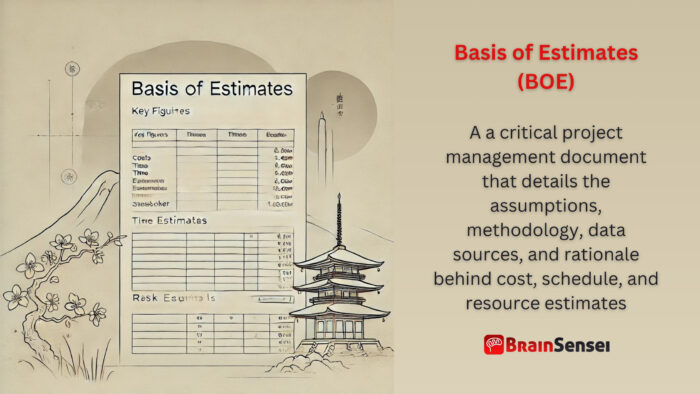
Basis of Estimates
What is the Basis of Estimates?
The basis of estimates (BOE) is a critical project management document that details the assumptions, methodology, data sources, and rationale behind cost, schedule, and resource estimates. It provides transparency in estimating processes, ensures stakeholders understand how figures were derived and increases confidence in project planning.
Key Takeaways
- Definition: The basis of Estimates documents the rationale and methodology used for project cost, schedule, and resource estimates.
- Purpose: Ensures transparency, consistency, and accuracy in project estimation.
- Key Components: Includes assumptions, data sources, methodologies, and risks associated with estimates.
- Benefits: Enhances stakeholder trust, supports risk management, and improves project control.
- Use Cases: Commonly used in government, construction, IT, and engineering projects for cost justification and decision-making.
Understanding Basis of Estimates
How It Works
The Basis of Estimates is structured to provide a clear breakdown of estimated costs and timelines based on predefined methodologies. Project managers and estimators rely on this documentation to:
- Justify cost estimates through historical data, expert judgment, or parametric models.
- Identify underlying assumptions affecting estimates, such as labour rates and material costs.
- List risk factors and contingencies to manage uncertainties effectively.
- Align estimation processes with industry best practices, ensuring consistency across projects.
Notes
- Consistency is crucial: Using a standardized BOE format improves clarity across multiple projects.
- Documenting assumptions: Clearly stating assumptions prevents misunderstandings in project execution.
- Review and validation: Estimates should undergo peer reviews or audits to enhance credibility.
- Updating estimates: BOE should be revised as new information arises or project scope changes.
- Alignment with project scope: Estimates must align with the scope definition to prevent scope creep.
Related Terms
Understanding BOE in project management requires familiarity with related terms:
- Estimate at Completion (EAC): The projected total cost of a project at completion based on current performance trends.
- Cost Estimate: The prediction of project costs based on labour, materials, and other expenses.
- Work Breakdown Structure (WBS): A hierarchical project work breakdown that supports detailed cost estimation.
- Parametric Estimating: A technique using statistical relationships between historical data and project variables to estimate costs.
- Bottom-Up Estimating: A method where estimates are calculated at a granular level and aggregated for overall project costs.
Examples of Basis of Estimates in Industries
Construction
In a large-scale infrastructure project, such as a highway expansion, the BOE would document cost estimates based on:
- Historical data from similar projects
- Material cost projections from suppliers
- Labor rate assumptions considering local wage laws
- Environmental impact assessment scheduling
- Risk factors such as weather delays and regulatory approvals
For example, in a recent highway expansion project in California, the BOE was crucial in ensuring cost transparency and project feasibility. The project required extensive cost modelling using data from past highway projects in the state. Construction firms referenced historical asphalt, steel, and concrete costs, factoring in inflation and market fluctuations. Additionally, the BOE accounted for labour costs, which varied across different counties due to local union agreements. Environmental assessments identified potential delays due to protected wetlands, requiring contingency planning. By meticulously documenting these details, project managers ensured that estimates were realistic and justifiable, leading to a well-executed project within budget.
IT & Software Development
A software development project for a government agency uses BOE to justify:
- Develop hourly rates based on market benchmarks
- Complexity factors influencing coding and testing timelines
- Hardware and software procurement costs
- Potential risks such as cybersecurity threats or scope changes
- Contingency planning for unexpected project delays
For instance, in a cloud migration project for a federal agency, BOE was instrumental in securing funding and stakeholder buy-in. The document outlined hourly rates for front-end and back-end developers sourced from national labour statistics and vendor contracts. The team applied a complexity factor to the estimate based on the number of systems that required integration, adding buffer time for unforeseen compatibility issues. Hardware costs, including high-performance servers, were justified using vendor quotes and historical procurement data. Additionally, the BOE accounted for cybersecurity measures, estimating costs for penetration testing and encryption protocols. With detailed documentation, the project secured approval and stayed on track despite minor scope adjustments.
Aerospace & Defense
For a satellite development project, BOE includes:
- Engineering design estimates based on parametric modeling
- Manufacturing costs adjusted for material price fluctuations
- Testing and quality assurance processes
- Compliance costs for government and international regulations
- Contingency reserves for unforeseen technological challenges
A notable case study in the aerospace industry is a satellite launch program by a European space agency. The BOE outlined a cost estimation strategy based on prior satellite missions, adjusting for technological advancements and changes in raw material costs. Engineers used parametric estimating to predict the cost of propulsion systems, considering the weight and fuel efficiency of newer models. Manufacturing estimates factored in titanium and composite material price trends, ensuring realistic budget projections. Compliance costs were critical, as international regulations required extensive documentation and quality assurance testing before launch approval. By leveraging a well-structured BOE, the agency successfully managed budget expectations and secured continued funding from government stakeholders, ensuring the mission’s success.
Use Cases of Basis of Estimates
United States (U.S. Federal Government Contracting)
U.S. government contracts, particularly those related to defence and infrastructure, require comprehensive BOEs for cost transparency. In large defence procurement projects like aircraft manufacturing, contractors must submit BOE documents detailing cost assumptions, labour estimates, and risk assessments. These documents ensure compliance with Federal Acquisition Regulations (FAR) and help auditors assess cost realism. A well-documented BOE prevents disputes, fosters accountability, and efficiently allocates taxpayer money.
United Kingdom (Renewable Energy Projects)
BOEs are essential for securing investment in renewable energy projects, such as offshore wind farms in the North Sea. The document provides detailed estimates on turbine procurement, construction labour, maintenance costs, and government subsidies. Renewable energy companies can gain investor confidence and obtain regulatory approvals by clearly outlining the financial justification. Additionally, BOEs help track project financial performance, ensuring estimates align with actual expenditures.
Japan (Infrastructure Development)
Asia’s rapid urbanization has driven significant investment in infrastructure, requiring accurate BOEs. High-speed rail networks, for instance, demand precise cost estimations for land acquisition, material procurement, and long-term operational expenses. BOE documents are critical in coordinating costs between local governments, private sector investors, and international suppliers in Japan’s Shinkansen projects. Detailed estimates ensure fair contract negotiations, minimize cost overruns, and support large-scale project execution.
By leveraging BOEs, governments and private companies can maintain financial control over projects, reduce risks, and enhance transparency in project execution.
Best Practices for Basis of Estimates
Ignoring BOE best practices can lead to cost overruns, inaccurate budgeting, and loss of stakeholder trust. To avoid these pitfalls, organizations should consider the following approaches:
Use Historical Data Effectively
One of the best ways to ensure accurate estimates is to reference historical data from past projects. Analyzing trends, material costs, labour rates, and unforeseen risks in previous projects allows estimators to make informed decisions. However, analysts must contextualize historical data, accounting for inflation, market changes, and technological advancements.
For example, a construction company bidding on a new bridge project can analyze past projects to determine realistic cost expectations. By adjusting for inflation, regulatory changes, and new material technologies, the estimator can refine the BOE to reflect current market conditions.
Apply Multiple Estimation Methods
Different estimation methodologies yield different perspectives on project costs and schedules. Project managers can create a more balanced and accurate BOE by combining expert judgment, parametric, and bottom-up estimating.
For instance, expert judgment may be used in an IT software development project to estimate coding complexity, parametric estimating may predict effort based on historical development trends, and bottom-up estimating can break down individual feature costs for aggregation. Integrating multiple methods minimizes estimation errors and ensures comprehensive cost assessment.
Account for Risks and Contingencies
Every project has risks; failing to include contingency planning in BOE can result in cost overruns. Best practices suggest allocating contingency reserves based on project complexity, historical risk data, and expert analysis.
For example, an aerospace project with experimental technology might allocate a 20% contingency for unexpected design or testing failures. In contrast, a routine manufacturing project might only require a 5% contingency. Documenting these assumptions within BOE helps stakeholders understand the reasoning behind cost buffers.
Regularly Update Estimates
Teams should not keep the BOE static; they must review and update it as project conditions evolve. Frequent updates ensure that cost and schedule estimates remain relevant despite scope changes, labour fluctuations, or unforeseen delays.
For example, material costs may rise in an infrastructure project due to supply chain disruptions. Regular BOE updates allow for proactive budget adjustments, preventing last-minute cost overruns that could jeopardize project feasibility.
Ensure Stakeholder Involvement
Stakeholder involvement in BOE development improves estimate accuracy and buy-in. Project managers, financial analysts, procurement teams, and engineers should collaborate to develop, review, and validate estimates.
For example, in a renewable energy project, engineers may estimate the cost of solar panel installation while procurement teams provide real-time market pricing for photovoltaic cells. By incorporating input from different departments, the BOE captures a holistic view of project expenses and reduces estimation bias.
Utilize Estimation Software and Tools
Technology can streamline estimation processes and improve accuracy. Many industries use specialized software for cost estimation, such as Primavera, Procore, or CostX. These tools integrate data in real-time, reducing errors associated with manual calculations.
For example, parametric cost estimating software can model cost relationships based on historical data and project scope in a defence project. By automating complex calculations, project managers can refine estimates with greater precision and confidence
Maintain Transparent Documentation
Teams should thoroughly document the BOE with justifications for all cost assumptions, methodologies, and data sources. Transparent documentation reduces the likelihood of disputes and supports audits, funding approvals, and regulatory compliance.
For example, a transportation department submitting a BOE for a new subway system must document how it derived labour costs, material pricing, and project schedules. Well-documented BOE allows government auditors and stakeholders to trace the estimation process, ensuring credibility.
Conduct Peer Reviews and Audits
Independent reviews by peers or external auditors enhance BOE accuracy. Reviews identify potential estimation gaps, unrealistic assumptions, or overlooked risks, ensuring a higher degree of confidence in project estimates.
For example, a pharmaceutical company estimating the cost of a new drug development pipeline may have its BOE reviewed by financial analysts and regulatory experts. Their feedback ensures that teams accurately account for clinical trial costs, compliance fees, and production expenses.
Conclusion: Adhering to best practices for the Basis of Estimates enhances cost prediction accuracy, prevents financial surprises, and strengthens project viability. By leveraging historical data, multiple estimation methods, risk planning, stakeholder collaboration, and modern estimation tools, organizations can produce reliable BOE documents that serve as a foundation for project success. Ultimately, BOE is not just about numbers but about ensuring clarity, accountability, and informed decision-making throughout a project’s lifecycle.
Basis of Estimates: Common Mistakes and Issues
Errors in the Basis of Estimates can lead to severe financial and operational setbacks. Here are some of the most common mistakes and their consequences:
Inadequate Documentation of Assumptions
One of the most frequent errors in BOE preparation is failing to document the assumptions behind cost estimates. Stakeholders may misinterpret estimates without transparent assumptions, leading to unrealistic expectations and potential disputes.
For instance, an estimator might assume that material prices will remain stable in a construction project. Still, the project could exceed its budget if inflation or supply chain disruptions cause rising costs. A well-documented BOE should include assumptions regarding material costs, labour rates, and potential economic fluctuations.
Overlooking Risk and Contingencies
Many project managers fail to incorporate adequate risk analysis and contingency reserves into their BOE. Failing to account for unforeseen challenges can cause budget overruns.
For example, cybersecurity risks might not be adequately accounted for in an IT infrastructure project, leading to additional costs if a security breach occurs. A robust BOE should include a risk analysis that identifies potential threats and allocates contingency funds accordingly.
Relying Solely on One Estimation Method
Using only one estimation method—such as expert judgment or historical data—can result in inaccurate cost projections. A balanced BOE should integrate multiple techniques, such as parametric, bottom-up, and three-point estimating.
For example, a defence project might rely solely on historical cost data from previous military contracts. Historical data alone cannot accurately estimate the development of new technologies. Instead, parametric modelling and expert input should complement historical cost trends.
Ignoring Scope Changes
If teams fail to update the BOE when the project scope changes, they can cause severe miscalculations. Scope creep—adding additional features or requirements without adjusting estimates—often results in budget overruns.
Consider an aerospace project with an additional safety feature mandated midway through development. Failure to update the BOE with the new engineering costs will significantly underestimate the final budget. Proper change management practices should ensure that BOE adjustments align with project scope modifications.
Poor Stakeholder Communication
A BOE is only effective if stakeholders understand its components. Many project managers draft highly technical BOEs that lack clarity, making it difficult for decision-makers to interpret and validate estimates.
For instance, using overly technical language without clear explanations in cost justifications for a government infrastructure project will delay budget approvals through misunderstandings. A best practice is to provide an executive summary in plain language alongside the detailed BOE.
Not Conducting Independent Reviews
Failing to validate estimates through peer reviews or third-party audits increases the likelihood of errors. Independent reviews objectively assess cost assumptions and help identify estimation flaws before they impact the project.
For example, a pharmaceutical company developing a new drug may estimate clinical trial costs without independent verification. If third-party auditors reveal flaws in patient recruitment cost assumptions, stakeholders can adjust before securing funding, preventing financial shortfalls.
Misalignment with Project Objectives
Cost estimates may be misleading if a BOE does not align with the project goals and business objectives. Project teams should ensure that estimated costs, schedules, and resources reflect the organization’s strategic priorities.
For example, an energy company planning a wind farm might focus on minimizing initial costs. If the BOE fails to account for long-term maintenance and operational efficiency, it will compromise the project’s financial sustainability. A comprehensive BOE should reflect both short-term and long-term cost considerations.
Conclusion: Errors in the Basis of Estimates can have significant consequences, including budget overruns, schedule delays, and stakeholder disputes. By ensuring thorough documentation of assumptions, incorporating risk analysis, using multiple estimation methods, and maintaining open stakeholder communication, project managers can create reliable and effective BOEs. Regular updates and independent reviews further enhance accuracy, reducing the likelihood of costly errors and ensuring project success.
Basis of Estimates: Frequently Asked Questions (FAQs)
Why is the Basis of Estimates critical in project management?
BOE ensures transparency in estimating costs, schedules, and resources, helping stakeholders make informed decisions and mitigating project risks.
How is BOE different from a cost estimate?
A cost estimate provides a numerical forecast, while BOE documents the methodology and assumptions behind that forecast.
Who is responsible for preparing BOE?
Project estimators, financial analysts, and project managers typically collaborate to develop BOE, ensuring accuracy and accountability.
How often should BOE be updated?
BOE should be reviewed and updated whenever significant project changes occur, such as scope modifications or unforeseen risks.
What are the consequences of incorrectly documenting the BOE?
Inadequate BOE documentation can lead to cost overruns, misaligned expectations, and increased project risk due to a lack of justification for estimates.
Additional Resources
- AACE International Total Cost Management Framework
- Project Cost Management: Principles, Tools, Techniques, and Best Practices for Project Finance
Preparing for a PMI certification?
- Exam Prep Courses: PMP®, CAPM®, and PMI-ACP®
- Exam Simulators: PMP®, CAPM®, PMI-ACP®, PMI-PBA®, PMI-RMP®, PMI-SP®, PgMP®, and PfMP®
- Professional Development Units (PDUs): 15, 30, and 60 PDU Bundles



